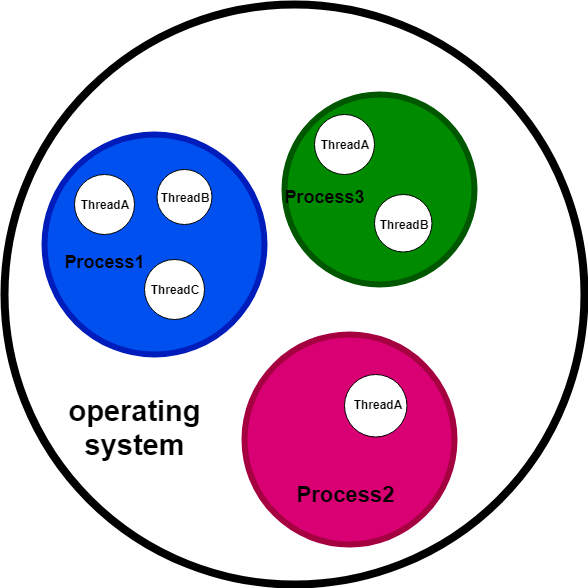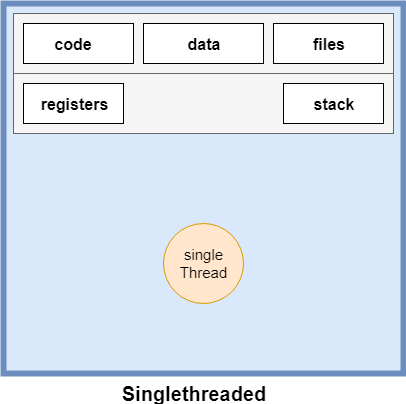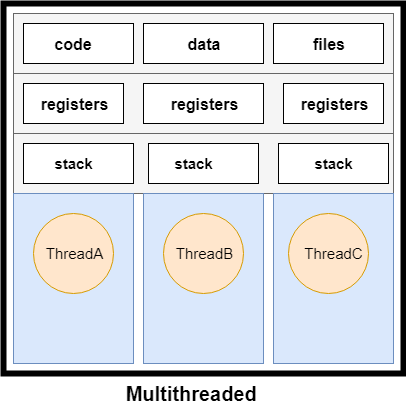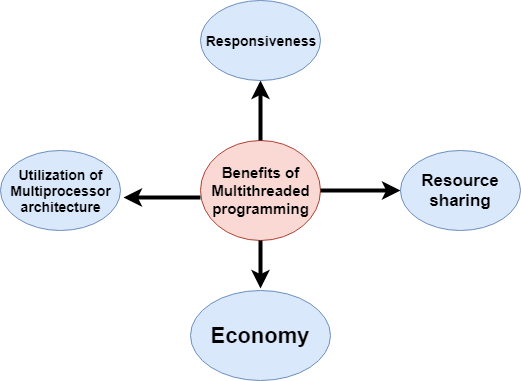Process and Thread in Java
Process
It is a program that is running on your computer. The process is a heavy-weight, which takes memory separately to other processes. The process may be a small background task like spell-checker; it may be internet explorer or Microsoft word. All processes have one or more threads. The process performs a series of operations on a set of data.
The processes are created, scheduled, and terminated by the operating system for the use of the CPU. The operations of the process are controlled with the help of PCB (Process Control Block). PCB can be considered as the brain of the process having all the crucial information of a process like its process id, priority, state, contents CPU register, and PWS.
PCB is considered as the kernel-based data structure, which provides the three kinds of functions which are scheduling, dispatching, and context save.
Scheduling: It chooses(decides) which process is (run)executed first in the CPU.
Dispatching: An environment is set up for the execution of the process.
Context save: It saves the information regarding a process when it gets resumed or blocked.

The process is a program in execution. The operating system has to allocate the resources; every process uses these resources and releases the resources on the process termination. These increase the responsibility of the operating system to provide all these resources to a process. In turn, the operating system has a burden to manage these processes and to schedule the process. If there are many processes created in the system, a point will come where the operating system will not be able to allocate these resources to any process, and in turn, the system will get hung. To solve this concept of threads was implemented.
The process life cycle has certain states included, such as ready, running, blocked, and terminated. For consisting of the track of the processing activity at an instant, its states are used.
Processes provide the medium to achieve the concurrent execution of a program. The child process is created by the chief process of a concurrent program. The main process and child process need to interact with each other for completing the common task.
Feature of Process
- The process has process id, CPU registers, memory locations, stack.
- The process has its own virtual address space.
- It provides protected access to processors, other processes, files, and I/O.
- The process is a heavyweight.
- The creation of a process includes system calls for each process separately.
- A single process does not share data and information and takes its isolated memory space.
- The IPC (Inter-process communication) mechanism for communication is used by the processes, which significantly increases the number of system calls.
- More system calls are consumed by Process management.
- Every process contains the stack and heap memory, instruction, data, and memory map.
Thread
A thread is a lightweight process that shares the memory of a single process. It supports Multithreading. Each thread relates to exactly one process, and no thread can exist outside a process. Threads represent a software approach to improve the performance of the operating system. They also specify a suitable mechanism for parallel execution of applications on shared-memory multiprocessors. Threads are not independent of one another; that is why they share their code section, data section, and OS resources (like open files and signals) with each other. But a thread has its program counter (PC), register set, and stack space just like a process. The kernel provides a stack and a thread control block (TCB) to every thread. The Threads mainly have the states called the running, ready, and blocked states; it only includes computational state, not resource allocation, and communication state, which reduces the switching overhead. It enhances the concurrency (parallelism) because the many threads are the parts of the single process. So, each thread is assigned to do the task to speed up to complete the task.
When multiple threads are active, JVM provides the default priorities to each thread. The priority of the thread specifies the time available for execution relative to other active threads in the same process.
Feature of Thread:
- As a single process is executing for a single task, a thread may be part of the process, and it may execute a part of the process; hence it becomes the lightweight process. Thus, a single process may have many such threads that will take care of one part of the execution of that whole process. So, every thread that created or that is generated in a process also has its characteristics.
- Thread comprises a thread id, a program counter, a register set, and a stack as processes have process id, CPU registers, memory locations. The thread id is distinguished every thread.
- Threads share the resources of the process and are executing some part of the process
- Processes with threads are categories as following: The process may have the one or multithreaded.
- More than one thread (Lightweight process) is created by only one system call.
- Thread management does account for no or fewer system calls because communication between threads can be achieved using shared memory.
7. The process’s isolation property increases its overhead in terms of resource consumption.
Single-threaded
Single-threaded refers to executing an entire process from beginning to end without interruption by a single thread. Here, every process is associated with registers, stack, code, data, files, which is used by a single thread. This process contains a single thread that is executing only one work for a process at a time.

For Example: If a web server is a single-threaded process, so web server will handle only a single request at a time, and all other users have to wait till this one request completed.
Multithreaded
Multithreaded refers to allowing multiple threads within a process so that they are executed independently while sharing their resources.
Here every thread will have its registers and stack that will store the information or store the work done by these particular threads in these registers and the stack.

As this is the multithreaded process, the threads execute in the same resources that are being allotted to a process; hence multithreaded process or a thread is said to be the lightweight process as it does not require in additional resources to execute.
For example:
- In the Multithreaded web server, every thread will be assigned to each user, and every user will able to access the required information from the webserver.
- Similarly, the word processor will have a thread to access the data from the user simultaneously. Another thread will execute to find out the error, spelling mistakes that will be typed by the user, whereas other threads engage in the loading of the files, which are required in the word processor.
Benefits of Multithreaded over Single threaded:

Responsiveness
By using Multithreading, it allows a program to run even if part of it is blocked. A program continuously runs also if the process is performing a lengthy operation.
As many threads execute simultaneously for any single process, it increases the responsiveness of a process as many threads doing the same job will improve the response of the process. In an interactive application, we allow the program to continue running even if a part is blocked or is performing some lengthy operation; still, the application will respond because of Multithreaded.
Resource sharing
A single application can have many threads within the same address space for sharing the resources that are allocated to the process.
As threads are the parts of the same process, they share the memory and resource of the process to which they belong. The thread belongs to a specific process that is executing some instruction, so these allow the benefit of code sharing for an application so different threads may execute various activities for an application in the same address space.
Economy
To create processes relates to more expensive and time-consuming as they require more memory and resources as compared to threads. Management and creation are much higher than thread creation and management.
Every thread executes in the process to which it belongs. The threads do not have to allocate the new memory space or the resources, so they reduce the resource utilization of the operating system. There is not much more need for context switching between the processes as every thread is the part of the same process and executing a particular part of the process, so the context switching of the process is reduced, and that in turn reduces the resource requirement of any operating system. Thus, it removes the overhead for creating and maintaining a process rather than a thread.
Utilization of multiprocessor architectures
In this architecture, each thread can run on a different processor in parallel using multithreading. This increases the concurrency of the system. In contrast, a single processor system, where only one process or thread can run on a processor at a time.
We can utilize the full power of multiprocessor architectures where every thread can be assigned to a processor for some job. The multiple processors in the multiprocessor systems will execute one single job that may be part of a big processor, so this increases the speed of execution or speed of executing the processes highly by running parallel instructions on a different processor.
A Single-threaded process will run only on the one processor even there are many processors available for execution. In contrast, the Multithreaded process will utilize all the processors that are available in the system.
What is the difference between Process and the Thread?
| Process | Thread |
| The process is resource-intensive or heavyweight. | Thread is taking lesser resources than a process and lightweight. |
| Process switching requires interaction with the operating system. | The switching of the thread need not require to interact with the operating system. |
| All process has the same code but has its own private memory and file resources in multiple processing environments. | All threads are sharing the same set of resources and open files of the processes. |
| There is no other process can execute until the first process is unblocked. | If one thread is blocked and waiting, the other thread in the same task can run. |
| Without using threads, use more resources by the process. | Multiple threaded processes use fewer resources. |
| Every process operates independently of the others. | Threads are not independent among themselves as one thread can read, write, or change another thread’s data. |
How does the Thread differ from the Process?
Faster context switch
A context switch occurs when the computer’s CPU switches(move) from a process or thread to a different process or thread. Context switching allows a CPU to handle multiple processes or threads without the need for additional processors. A (computer’s CPU) processor follows to change (switches) from one task to another while ensuring that tasks do not conflict.
Context switching involves storing the state or context of a process or thread so that it can be reloaded when the need arises, and execution can be resumed from the same point. This is the multitasking feature of the operating system and permits a single processor to be shared by multiple processes.
Context switching time between threads is lower compared to process context switch because threads relate to the shared memory as compared to the process. Process context switching consists of more overhead of the CPU as compared to threads context switching.
Communication
To communicate between multiple threads is easy as they share common address space (share memory). At the same time in the process, we have to follow some specific communication techniques (i.e., more system calls, etc.) for communication between processes because they do not share the memory space.
Enhanced throughput of the system
In the Multithreading mechanism, each thread has a function that is considered as one job, then the number of jobs completed per unit of time is increased, thus increasing the throughput of the system.
Resource sharing
Among all threads within a process, share resources like code, data, and files. But the process does not share anything.
Effective utilization of multiprocessor system
If a single process has multiple threads, then we can schedule these threads on multiple processors. This mechanism will lead to process execution faster. But the complete process that are assigns to a processor takes time to finish according to its activity completion. The threads of-course increase the efficiency inside the process, but different processes complete after depends upon its activities to terminate.
Multitasking in Java
Multitasking is the mechanism in which a user performs more than one computer task at a time. The operating system can keep track of where you are in these tasks and go from one to the other without losing information. It is the way of executing several multiple tasks simultaneously. The operating systems which involve in the Multitasking are Microsoft Windows 2000, IBM ’s OS/390, and Linux.
Real-Life Example - classroom student is the best way of executing Multitasking.
- Students are listening to class.
- They are taking running notes of essential points.
- They are checking the mobile phone in the class by many students.
- They are observing the teacher’s way of teaching.
Types of Multitasking
1. Process-based Multitasking
2. Thread-based Multitasking.
Process-based Multitasking: Executing several multiple tasks simultaneously, where each task is a separate independent program(process), is the process-based Multitasking.
Example –All these three activities will be performed simultaneously, and each task is independent of each other.
- Typing the java program in the editor
- Listening to the songs from the same system.
- Download a file from the internet.
While typing a java program in the editor, we can listen to audio songs from the same system at the same time we can download your file from the net. All these tasks will be executed simultaneously and independently of each other hence it is process-based Multitasking. It is better for the operating system level.
Thread based Multitasking:
It is the process of executing several tasks simultaneously where each task is a separate independent part of the same program. Such type of Multitasking is called Thread based Multitasking, and each independent part is called Thread. It is suitable for programming level
Example: In a program, there are 10,000 lines of words. The first 5000 lines of code are independent to other 5000 lines of code that means first related to the first customer and second relates to another customer, so no need to wait to execute second customer lines of code after first lines of code. Both parts can be run simultaneously of the same program, so hardly less time to take to complete the execution. The first independent part and second independent part executing separate tasks simultaneously where each part is a separate independent part of the same program, and each independent task is Thread This type of Multitasking is Multithreading.
What is the difference between the Process and Thread based Multitasking?
| Process-based Multitasking | Thread-based Multitasking |
| Context switching is costing | Context switching is not more costing |
| There is a separate address space for every process. | Every thread shares one address space. |
| Each task is a separate independent process. | Each task is the separate individual part of the same program. |